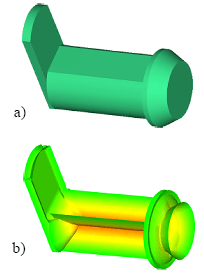Medial axis

The medial axis of an object is the set of all points having more than one closest point on the object's boundary. Originally referred to as the topological skeleton, it was introduced by Blum [1] as a tool for biological shape recognition. In mathematics the closure of the medial axis is known as the cut locus.
In 2D, the medial axis of a subset S which is bounded by planar curve C is the locus of the centers of circles that are tangent to curve C in two or more points, where all such circles are contained in S. (It follows that the medial axis itself is contained in S.) The medial axis of a simple polygon is a tree whose leaves are the vertices of the polygon, and whose edges are either straight segments or arcs of parabolas.
The medial axis together with the associated radius function of the maximally inscribed discs is called the medial axis transform (MAT). The medial axis transform is a complete shape descriptor (see also shape analysis), meaning that it can be used to reconstruct the shape of the original domain.
The medial axis is a subset of the symmetry set, which is defined similarly, except that it also includes circles not contained in S. (Hence, the symmetry set of S generally extends to infinity, similar to the Voronoi diagram of a point set.)
The medial axis generalizes to k-dimensional hypersurfaces by replacing 2D circles with k-dimension hyperspheres. The 2D medial axis is useful for character and object recognition, while the 3D medial axis has applications in surface reconstruction for physical models, and for dimensional reduction of complex models.
If S is given by a unit speed parametrisation , and is the unit tangent vector at each point. Then there will be a bitangent circle with center c and radius r if
For most curves, the symmetry set will form a one-dimensional curve and can contain cusps. The symmetry set has end points corresponding to the vertices of S.

See also
- Grassfire transform
- Voronoi diagram – which can be regarded as a discrete form of the medial axis.
- Straight skeleton
- Local feature size
External links
- The Scale Axis Transform – a generalization of the medial axis
- Straight Skeleton for polygon with holes – Straight Skeleton builder implemented in java.
- Multi-layered medial axis – a generalization of the medial axis (for e.g. representing an airport or a multi-storey building)
References
- ↑ A transformation for extracting new descriptors of shape H Blum, Models for the perception of speech and visual form, 1967
- From the Infinitely Large to the Infinitely Small: Applications of Medial Symmetry Representations of Shape Frederic F. Leymarie1 and Benjamin B. Kimia2
- "3D Skeletons: A State-of-the-Art Report" Andrea Tagliasacchi, Thomas Delame, Michela Spagnuolo, Nina Amenta and Alexandru Telea